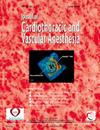Preoperative Rectus Femoris Muscle Characteristics as Predictors of Postoperative Walking Ability in Elderly Cardiac Surgery Patients: A Prospective Observational Study
IF 2.1
4区 医学
Q2 ANESTHESIOLOGY
Journal of cardiothoracic and vascular anesthesia
Pub Date : 2025-08-05
DOI:10.1053/j.jvca.2025.07.041
引用次数: 0
Abstract
Objective
Postoperative walking ability has been identified as a crucial prognostic indicator for older patients undergoing major cardiac surgeries. This study was designed to investigate the predictive value of preoperative lower extremity muscle mass and muscle echo intensity for postoperative walking ability in older patients undergoing cardiac surgeries.
Design
A prospective observational study.
Setting
A single-center study conducted at a university hospital.
Participants
A total of 109 elective cardiac surgery patients, 65 years of age or older, were prospectively enrolled.
Interventions
Preoperative muscle mass and quality of the rectus femoris were assessed using muscle cross-sectional area and echo intensity on ultrasound images, respectively.
Measurements and Main Results
The primary outcome of interest was the walking distance achieved in a 6-minute walk test after cardiac surgery. Multiple regression analysis was performed to identify factors independently associated with 6-minute walk distance after surgery. Higher muscle cross-sectional area and lower echo intensity of the rectus femoris, measured by ultrasonography, were associated with a significantly longer 6-minute walk distance upon discharge. Higher muscle mass and lower echo intensity were also significantly associated with shorter hospital length of stay.
Conclusions
The preoperative measurement of cross-sectional area and echo intensity of the quadriceps muscles can be used as a predictor of postoperative 6-minute walk distance in elderly patients undergoing cardiac surgery.
术前股直肌特征作为老年心脏手术患者术后行走能力的预测因素:一项前瞻性观察研究
目的:老年心脏大手术患者术后行走能力被认为是一项重要的预后指标。本研究旨在探讨术前下肢肌肉量和肌肉回声强度对老年心脏手术患者术后行走能力的预测价值。设计:前瞻性观察性研究。环境:在大学医院进行的单中心研究。参与者:共纳入109例选择性心脏手术患者,年龄≥65岁。干预措施:术前分别使用超声图像上的肌肉横截面积和回声强度评估股直肌的肌肉量和质量。测量方法和主要结果:主要研究结果是心脏手术后6分钟步行测试的步行距离。进行多元回归分析以确定与术后6分钟步行距离相关的独立因素。超声测量股骨直肌的高肌肉截面积和低回波强度与出院时明显延长6分钟步行距离有关。较高的肌肉质量和较低的回声强度也与较短的住院时间显著相关。结论:术前测量股四头肌的横截面积和回波强度可作为老年心脏手术患者术后6分钟步行距离的预测指标。
本文章由计算机程序翻译,如有差异,请以英文原文为准。
求助全文
约1分钟内获得全文
求助全文
来源期刊
CiteScore
4.80
自引率
17.90%
发文量
606
审稿时长
37 days
期刊介绍:
The Journal of Cardiothoracic and Vascular Anesthesia is primarily aimed at anesthesiologists who deal with patients undergoing cardiac, thoracic or vascular surgical procedures. JCVA features a multidisciplinary approach, with contributions from cardiac, vascular and thoracic surgeons, cardiologists, and other related specialists. Emphasis is placed on rapid publication of clinically relevant material.

 求助内容:
求助内容: 应助结果提醒方式:
应助结果提醒方式:


